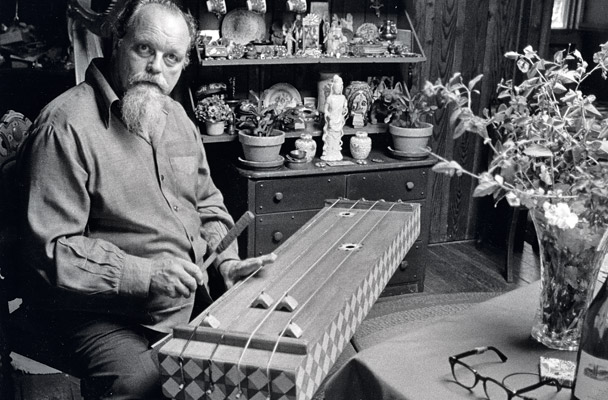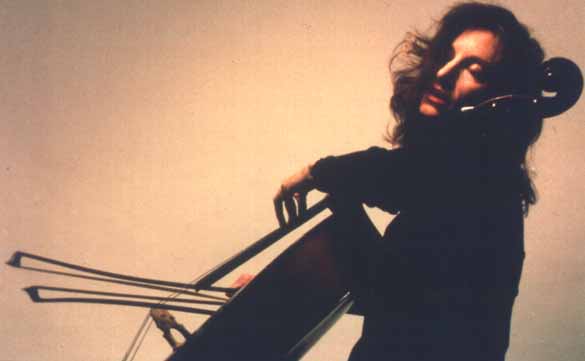Roger Reynolds at the Phillips Collection
By Stephen Brookes • The Washington Post • March 5, 2011
The composer Roger Reynolds - complete with electro-shocked gray hair and a mischievous, "let's-smash-a-few-conventions" glint in his eye - was in town on Thursday night, reinventing the classical music concert. Reynolds has little use for traditional "directed" performances, with their active musicians and passive listeners, so he searches out unconventional spaces, fills them with sound from every direction and lets listeners explore the music as they will. In years past, he's brought huge, epic works to the atrium of the National Gallery of Art, but on Thursday he scaled things back to a more intimate level, with three new works for guitar and computer at the Phillips Collection. Roger ReynoldsThe event took place in a gallery dominated by two monumental prints (titled, rather musically, "As Time Goes By") by British artist Howard Hodgkin: twenty-foot-long explosions of color on opposite walls, with room between them for about 60 people, four speakers and guitarist Pablo Gomez and computer musician Jaime Oliver, who sat in a tangled nest of wires and electronics.
Roger ReynoldsThe event took place in a gallery dominated by two monumental prints (titled, rather musically, "As Time Goes By") by British artist Howard Hodgkin: twenty-foot-long explosions of color on opposite walls, with room between them for about 60 people, four speakers and guitarist Pablo Gomez and computer musician Jaime Oliver, who sat in a tangled nest of wires and electronics.
Gomez opened with two Reynolds works for solo guitar that both contrasted with and complemented each other: the assertive "imAge/guitar" (full of bold, eruptive gestures) and the more delicate "imagE/guitar" (a ravishing piece awash in shadows and evanescent mysteries). Both pushed the guitar to a demanding virtuosic edge, but Gomez kept the effect lyrical, the thinking coherent and the poetry intact.
Then things got really interesting. Oliver switched on his MacBook and joined Gomez for "Dream Mirror," which took material from the previous two guitar works, transformed it and sent it out through speakers around the gallery. The effect was electrifying, as if the computer had become a sort of meta-guitar, revealing a hidden universe of ideas, dreams, possibilities and memories behind the original works. Gomez's intimate, human-scale playing took on new depth and beauty against the otherworldly sounds Oliver was producing, and the result was a work of extraordinary lyricism: the lucid dreaming of a 21st-century poet.
Lou Harrison Festival this weekend!
 Exactly what we need in gray, mid-winter Washington: Two days of Lou Harrison! The great California composer (1917-2003) drew on an array of exotic materials, including Indonesian gamelan music, to achieve a gorgeous synthesis of West and East. Balm for the ears, warmth for the soul, and food for the mind.
Exactly what we need in gray, mid-winter Washington: Two days of Lou Harrison! The great California composer (1917-2003) drew on an array of exotic materials, including Indonesian gamelan music, to achieve a gorgeous synthesis of West and East. Balm for the ears, warmth for the soul, and food for the mind.
The Indonesian Embassy kicks the mini-festival off on Friday night with a conference/concert titled "Lou Harrison: Gamelan" from 7:30 to 9:30 pm, with the Wesleyan University Gamelan, Eva Soltes, and Harrison scholar Bill Alves.
But things really move into high gear on Saturday, when the Post Classical Ensemble presents a concert titled "Sublime Confluence: The Music of Lou Harrison," which includes the composer's Concerto for Piano and Javanese Gamelan, Bubaran Robert for Trumpet and Javanese Gamelan, Strict Songs for chorus and orchestra, and his Piano Concerto. Saturday night at 8 pm at Lisner Auditorium.
For more info, click here.
Shanghai Quartet and Wu Man at the Freer Gallery
By Stephen Brookes • The Washington Post • February 28, 2011
I
f, like most of us, you lie awake at night wondering what great things a string quartet could do if only it included a Chinese lute, you should have been at the Freer Gallery on Friday night, when the superb Shanghai Quartet and pipa superstar Wu Man joined forces. There were, of course, the usual lute-free quartets from Beethoven and Schumann, and a couple of folk-song-y works for solo pipa. But what raised the evening out of the ordinary - far, far out of the ordinary - was composer Lei Liang, who brought pipa and quartet together in a work so brilliantly original and inarguably gorgeous that the two may never be the same. Wu ManThe concert opened conventionally, with Beethoven's early Op. 18, No. 3 Quartet in D. It's a likable, rather gentle work in most hands, but the Shanghai players chose steel over charm and turned the thing into a powerhouse, playing with razor-sharp precision and pitiless logic. While it never quite achieved that spontaneous feel that makes these quartets sound fully alive, it was a wonderfully ferocious and illuminating performance nonetheless. Wu then took the stage (and shifted the tone) with Huiran Wang's delicate and light-filled "Dance of the Yi People" for solo pipa, which she brought off with effortless virtuosity.
Wu ManThe concert opened conventionally, with Beethoven's early Op. 18, No. 3 Quartet in D. It's a likable, rather gentle work in most hands, but the Shanghai players chose steel over charm and turned the thing into a powerhouse, playing with razor-sharp precision and pitiless logic. While it never quite achieved that spontaneous feel that makes these quartets sound fully alive, it was a wonderfully ferocious and illuminating performance nonetheless. Wu then took the stage (and shifted the tone) with Huiran Wang's delicate and light-filled "Dance of the Yi People" for solo pipa, which she brought off with effortless virtuosity.
But this was all prelude to Liang's "Five Seasons," a sonic tour de force from a composer not yet 40. Full of rapturous invention, it unfolded with all the naturalness of a turning planet as it worked its way through the cycle of birth, death and renewal. The pipa and the quartet achieved a kind of exuberant synergy together, as if each were leapfrogging over the other in a mad rush to expressive extremes, and when it ended, it ended too soon. The evening closed with Schumann's Quartet in A, Op. 41, No. 3, and as you would expect, heartstrings were tugged, garments were rent, and there was much Sturming und Dranging to and fro. All good fun, and the Shanghai brought it off with affection and tasteful restraint.
Andrius Zlabys and Adam Neiman at Dumbarton
By Stephen Brookes • The Washington Post • February 28, 2011
W
hen Frederic Chopin set off for a vacation in Majorca in 1838, he packed his mistress under one arm and a copy of Bach's "Well-Tempered Clavier" under the other. The Bach, at least, turned out to be a good choice of luggage: It became the inspiration for Chopin's astonishing set of 24 Preludes, Op. 28. Brief almost to the point of nonexistence - many are less than a minute long - they nevertheless lay bare aching depths of the human heart and, when played together, make up one of the most passionate, insightful works of the romantic era. Adam NeimanBut what, exactly, do the Preludes have to do with Bach's more austere and exalting work? That was the question posed at Historic Dumbarton Church on Saturday night, when Andrius Zlabys and Adam Neiman aimed their pianos at each other and, alternating back and forth, juxtaposed the two. It was a thought-provoking evening, a sort of conversation between the baroque and the romantic, full of contrasts and unexpected connections. The contrasts were plentiful: Chopin's emotionalism against Bach's Olympian detachment; funereal brooding against serene optimism; poetic, improvisatory tone-painting against perfectly worked-out counterpoint. But over the course of the evening, it became clear that both composers were doing the same thing: probing deeply into the human experience, from two vastly different perspectives.
Adam NeimanBut what, exactly, do the Preludes have to do with Bach's more austere and exalting work? That was the question posed at Historic Dumbarton Church on Saturday night, when Andrius Zlabys and Adam Neiman aimed their pianos at each other and, alternating back and forth, juxtaposed the two. It was a thought-provoking evening, a sort of conversation between the baroque and the romantic, full of contrasts and unexpected connections. The contrasts were plentiful: Chopin's emotionalism against Bach's Olympian detachment; funereal brooding against serene optimism; poetic, improvisatory tone-painting against perfectly worked-out counterpoint. But over the course of the evening, it became clear that both composers were doing the same thing: probing deeply into the human experience, from two vastly different perspectives.
Both Neiman and Zlabys are accomplished pianists, but it was Neiman's account of the Chopin that made the evening. Zlabys seemed a bit off his game; in truth, he seemed half asleep, and turned in an adequate but lackluster performance. Neiman, on the other hand, brought fire and real imagination to the Preludes, delivering transparent, detailed and sensitive readings of virtually everything he played.
Erkki-Sven Tüür and the New Tallinn Trio at the Phillips Collection
By Stephen Brookes • The Washington Post • February 26, 2011
Arvo Pärt may be the most celebrated composer to come out of Estonia, but to judge by a riveting concert at the Phillips Collection on Thursday night, the place is a smallish hotbed of serious musical talent. Erkki-Sven TüürTake, for instance, the composer Erkki-Sven Tüür, whose chamber music was the focus of the evening. Spare, probing, intense and extraordinarily characterful, Tuur's compositions work on an almost physical level, using insistent gestures to build structures of sound that are both powerful and deeply moving - and even, in the case of the final piece, downright exalting.
Erkki-Sven TüürTake, for instance, the composer Erkki-Sven Tüür, whose chamber music was the focus of the evening. Spare, probing, intense and extraordinarily characterful, Tuur's compositions work on an almost physical level, using insistent gestures to build structures of sound that are both powerful and deeply moving - and even, in the case of the final piece, downright exalting.
And Tüür couldn't ask for more committed interpreters than the New Tallinn Trio, superb Estonian musicians who turned in ear-searing playing throughout the evening. The concert (part of the Phillips's "Leading European Composers" series) opened with the trio "Architectonics VII," and many of the hallmarks of Tüür's music were quickly apparent. Evocative and unabashedly expressive, even playful, it spoke a modern but completely accessible language in which melody was never far from the surface, building repeated gestures and phrases into a powerhouse of momentum that was nothing less than exhilarating. That also held true in "Conversio," for violin and piano, a lighter and more delicate work - you were reminded of birds flying in a gusty wind - that developed into a wonderful perpetuum mobile before dissolving into fragments. Helena TulveThe lovely and almost pastoral "Dedication," for cello and piano, was full of yearning, though"Synergie," for violin and cello, seemed more academic and less satisfyingly natural than Tüür's other works. Another Estonian composer, Helena Tulve, was represented with "Lumineux/Opaque." Tulve is clearly fascinated with long, sustained sonorities; she builds colorful masses of sound and slides them into each other, and it was an intriguing, poetic work - even if all the glissando-ing had you reaching for the Dramamine at times. But the most purely beautiful music of the evening came at its close, with Tüür's "Fata Morgana," a work that, like the mirage it is named for, drew you in with shimmering, irresistible allure.
Helena TulveThe lovely and almost pastoral "Dedication," for cello and piano, was full of yearning, though"Synergie," for violin and cello, seemed more academic and less satisfyingly natural than Tüür's other works. Another Estonian composer, Helena Tulve, was represented with "Lumineux/Opaque." Tulve is clearly fascinated with long, sustained sonorities; she builds colorful masses of sound and slides them into each other, and it was an intriguing, poetic work - even if all the glissando-ing had you reaching for the Dramamine at times. But the most purely beautiful music of the evening came at its close, with Tüür's "Fata Morgana," a work that, like the mirage it is named for, drew you in with shimmering, irresistible allure.
Del Sol String Quartet at the Freer Gallery
By Stephen Brookes • The Washington Post • February 20, 2011
Worlds make interesting sounds when they collide; that may be the guiding principle behind the Freer Gallery's Meyer Concert Series, which has long been a showcase for some of the most adventurous, genre-smashing new music around. And on Saturday night, the Del Sol String Quartet, which specializes in smashing genres, teamed up with four traditional Chinese instrumentalists for an evening that tied together traditional Asian folk songs, avant-garde instrumental techniques, antique Persian modes and even a dash of Schubert. The results ranged from spectacular to irritating - but even the failures were worth hearing.
 Kui DongThe program got off to a lyrical start with Zhou Long's "Song of the Ch'in," but the meditative glow was quickly dispelled by Hyo-shin Na's "Song of the Beggars," an earthy work marked by insistent, Beethoven-ish gestures, dense clusters of sound and an agreeably unhinged quality. Paul Yeon Lee's "Ari, Ari ... ari" stormed the heavens with sweeping melodic gestures, romantic yearning and not even a speck of postmodern irony, while the Iranian composer Reza Vali used microtones and natural tuning to flavorful effect in "Nayshaboorak (Calligraphy no. 6)." The unrelenting density, though, of the piece - you felt you could park a truck on it - ultimately undermined its power. Koji Nakano's "Time Song III: Reincarnation 'The Birth of a Spirit' " was also a bit disappointing; while full of compelling ideas and imaginative instrumental writing, the yelps and grunts the players were required to emit just sounded awkward and affected.
Kui DongThe program got off to a lyrical start with Zhou Long's "Song of the Ch'in," but the meditative glow was quickly dispelled by Hyo-shin Na's "Song of the Beggars," an earthy work marked by insistent, Beethoven-ish gestures, dense clusters of sound and an agreeably unhinged quality. Paul Yeon Lee's "Ari, Ari ... ari" stormed the heavens with sweeping melodic gestures, romantic yearning and not even a speck of postmodern irony, while the Iranian composer Reza Vali used microtones and natural tuning to flavorful effect in "Nayshaboorak (Calligraphy no. 6)." The unrelenting density, though, of the piece - you felt you could park a truck on it - ultimately undermined its power. Koji Nakano's "Time Song III: Reincarnation 'The Birth of a Spirit' " was also a bit disappointing; while full of compelling ideas and imaginative instrumental writing, the yelps and grunts the players were required to emit just sounded awkward and affected.
The high point of the evening - by some margin - came at its end, with Kui Dong's "Spring, Summer, Autumn, and Winter Suite." It's a work of exceptional beauty and imagination, from its light-filled opening movement to the powerful and profound close, and Kui wove the sonorities of the quartet and the Chinese instruments together with a delicate, subtle touch. This is a composer to watch.
Frances-Marie Uitti at St. Mary's Church
By Stephen Brookes • The Washington Post • February 16, 2011
The spectacularly gifted cellist Frances-Marie Uitti has made a career out of demolishing musical boundaries. She has developed new techniques (most famously, playing with two bows simultaneously), collaborated with a who's who of contemporary composers, and pushed the cello into realms of unexpected beauty and expression. So the place to be Tuesday night for anyone interested in new music or the cello - or just innovative thinking in general - was St. Mary's Church in Foggy Bottom, where Uitti showed why she might be the most interesting cellist on the planet.
 Frances-Marie UittiSt. Mary's is an intimate space - perfect, as it turned out, for Uitti's intensely personal style. The program focused on solo works by composers often labeled "thorny," including the sometimes-brutal Salvatore Sciarrino, the English spectralist Jonathan Harvey, the enigmatic Gyorgy Kurtag and that visionary-by-any-standard Giacinto Scelsi. But Uitti made each work human, not only with her engaging prefatory remarks (she's worked with each of the composers) but with the riveting depth and lyricism of her playing. Sciarrino's "Ai Limiti della Notte" explored a delicate, often-whispered world of sound, Harvey's "Curve With Plateaux" was robust and wildly expressive and Kurtag employed Uitti's two-bow technique (one goes under the strings, the other, over) in his spare "Message to Frances-Marie." It was an evening of exceptional virtuosity and insight, particularly in Uitti's own "Rap't" and Scelsi's "Ygghur," perhaps the high point of the program.
Frances-Marie UittiSt. Mary's is an intimate space - perfect, as it turned out, for Uitti's intensely personal style. The program focused on solo works by composers often labeled "thorny," including the sometimes-brutal Salvatore Sciarrino, the English spectralist Jonathan Harvey, the enigmatic Gyorgy Kurtag and that visionary-by-any-standard Giacinto Scelsi. But Uitti made each work human, not only with her engaging prefatory remarks (she's worked with each of the composers) but with the riveting depth and lyricism of her playing. Sciarrino's "Ai Limiti della Notte" explored a delicate, often-whispered world of sound, Harvey's "Curve With Plateaux" was robust and wildly expressive and Kurtag employed Uitti's two-bow technique (one goes under the strings, the other, over) in his spare "Message to Frances-Marie." It was an evening of exceptional virtuosity and insight, particularly in Uitti's own "Rap't" and Scelsi's "Ygghur," perhaps the high point of the program.
The performance also featured the guitarist Ayman Fanous, who opened with improvisations on two of Heitor Villa-Lobos's notoriously difficult Etudes. Unlike the virtuosic Uitti, Fanous is largely self-taught, and while his love for the guitar was evident, so, alas, was his lack of formal training. But things picked up when Uitti joined him for a joint improvisation, and the evening closed with extemporaneous playing of rare intelligence and beauty.

